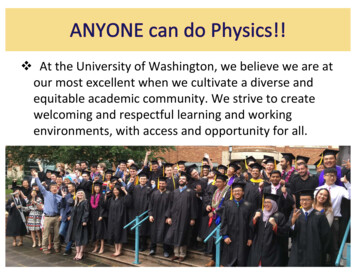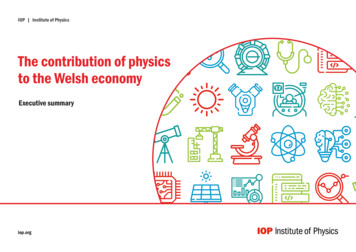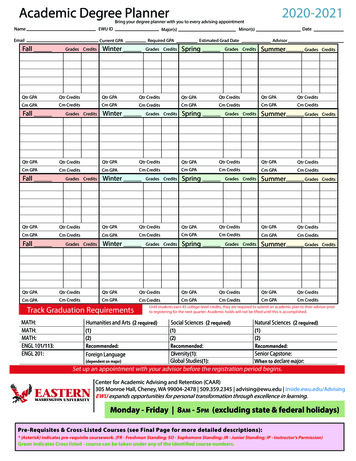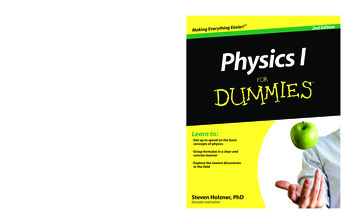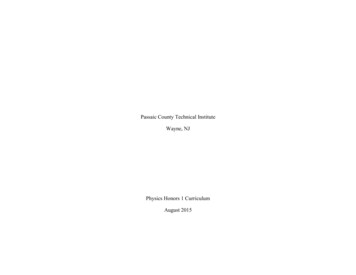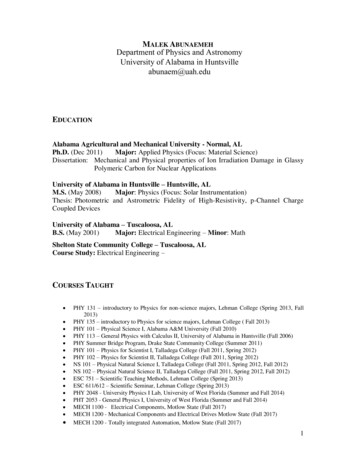
Transcription
MALEK ABUNAEMEHDepartment of Physics and AstronomyUniversity of Alabama in Huntsvilleabunaem@uah.eduEDUCATIONAlabama Agricultural and Mechanical University - Normal, ALPh.D. (Dec 2011)Major: Applied Physics (Focus: Material Science)Dissertation: Mechanical and Physical properties of Ion Irradiation Damage in GlassyPolymeric Carbon for Nuclear ApplicationsUniversity of Alabama in Huntsville – Huntsville, ALM.S. (May 2008)Major: Physics (Focus: Solar Instrumentation)Thesis: Photometric and Astrometric Fidelity of High-Resistivity, p-Channel ChargeCoupled DevicesUniversity of Alabama – Tuscaloosa, ALB.S. (May 2001)Major: Electrical Engineering – Minor: MathShelton State Community College – Tuscaloosa, ALCourse Study: Electrical Engineering –COURSES TAUGHT PHY 131 – introductory to Physics for non-science majors, Lehman College (Spring 2013, Fall2013)PHY 135 – introductory to Physics for science majors, Lehman College ( Fall 2013)PHY 101 – Physical Science I, Alabama A&M University (Fall 2010)PHY 113 – General Physics with Calculus II, University of Alabama in Huntsville (Fall 2006)PHY Summer Bridge Program, Drake State Community College (Summer 2011)PHY 101 – Physics for Scientist I, Talladega College (Fall 2011, Spring 2012)PHY 102 – Physics for Scientist II, Talladega College (Fall 2011, Spring 2012)NS 101 – Physical Natural Science I, Talladega College (Fall 2011, Spring 2012, Fall 2012)NS 102 – Physical Natural Science II, Talladega College (Fall 2011, Spring 2012, Fall 2012)ESC 751 – Scientific Teaching Methods, Lehman College (Spring 2013)ESC 611/612 – Scientific Seminar, Lehman College (Spring 2013)PHY 2048 - University Physics I Lab, University of West Florida (Summer and Fall 2014)PHT 2053 - General Physics I, University of West Florida (Summer and Fall 2014)MECH 1100 - Electrical Components, Motlow State (Fall 2017)MECH 1200 - Mechanical Components and Electrical Drives Motlow State (Fall 2017)MECH 1200 - Totally integrated Automation, Motlow State (Fall 2017)1
2 Malek Abunaemeh MECH 2300 - Automation systems, Motlow State (Fall 2017)MECH 1500 – Into to PLC programming, Motlow State (Spring 2018)MECH 2100 - Process control technology, Motlow State (Spring 2018)MECH 2400 Motor control, Motlow State (Spring 2018)MECH 2500- Mechanics and Machine elements, Motlow State (Spring 2018)PH 101 - Introduction to physics I with lab, University of Alabama in Huntsville (Fall 2018, Fall2019, Fall 2020)PH 102 – Introduction to physics II, University of Alabama in Huntsville (Spring 2019, Spring2020, Spring 2021)PH 111 – Physics with Calculus I for science and engineering (Fall 2019, Fall 2020)PH 112 – Physics with Calculus II for science and engineering (Summer 2019, Spring 2020,Spring 2021)PH113 – Physics with calculus III for science and engineering (Summer 2019, Fall 2020, Spring2021)PH116 – Physics with calculus III for science and engineering Lab (Summer 2019, Fall 2020,Spring 2021)PROFESSIONAL EXPERIENCE8/18 – PRESENTUniversity of Alabama in HuntsvilleHuntsville, ALPhysics Lecturer Teach physics courses to classes of up to 175 students per classTeach online coursesCoordinate lab for physic coursesSupervise graduate studentsIncorporate canvas into the lecturesWrite lab manual for PH 101 and PH 102Write lab manual for PH 1168/17 – 7/18Motlow State Community CollegeFayetteville, TNMechatronics lecturer Teach Various Mechatronics courses including PLC and Motors Served on Faculty Excellence committee Incorporate D2L in the course.5/14 – 8/15UNIVERSITY OF WEST FLORIDAPENSACOLA, FLPhysics Lecturer Teach Physics courses in the Department of Physics
3 Malek Abunaemeh Minority Speaker Award GrantServe on the Resource Allocation CommitteeDeveloped lab manual for University and General PhysicsIncorporate elearning and Mastering physics into course.1/13 – 12/13LEHMAN COLLEGE, CUNYBRONX, NYLecturer (Visiting line) Teach Physics courses in the Department of Physics and Astronomy Teach Teacher Education/Methods/Supervision courses in the Department ofMiddle & High School Education, Science Teacher Education Program Grant & Proposal writing (Spencer Foundation proposal, 100K in 10) Collaboration and coordination between Science Education and ScienceDepartments Develop curriculum aligned with the edTPA and Common Core State Standards Advise and mentor students Develop student research agendas Out-reach to local high schools Co-Developed STEM and English Language Learner ( ELLs) course designed todevelop skills in STEM educators to effectively meet the needs of ELLs in themainstream STEM classroom Department and University Service: Accepted Student Open House; NYCTFmentoring and support; Science Education edTPA working group.8/11 – 1/13Talladega College, Talladega, ALNatural Science and Mathematics DepartmentPhysics Professor Teach and manage all physics and physical science courses/labsNoyce Principal InvestigatorRecruit non-traditional students into the STEM fieldsMentor undergraduate studentsCurriculum review, revision and designAccreditation reportsMentor Department ProjectsMentor Student with projects for scholarly publicationsProposal and grant writingServe on various college committeesSetting up research facility
4 Malek Abunaemeh Serve as a resource for undergraduate studentsStudent advisement for STEM majors/minors5/08 – 8/11Alabama A&M University, Normal, ALPhysics DepartmentGraduate Teaching Assistant Teach and manage physical science courses Mentor undergraduate students Participate on various committees within the department Act as Primary Teaching Assistant Serve as a resource for graduate and undergraduate students5/08 – 8/11Alabama A&M University, Normal, ALCenter for Irradiation of MaterialsGraduate Research Assistant Perform Particle Induced X-ray Emission (PIXE), Rutherford BackscatteringSpectrometry (RBS) and Cyclic Voltammetry (CV) Perform Auger Electron Spectroscopy (AES), X-ray Photoelectron Spectroscopy(XPS) and Raman spectroscopy Operate a NEC Pelletron tandem accelerator Experience with manufacturing glassy polymeric carbon and silicon carbideceramics Developed research objectives and projects for high school summer interns Mentor undergraduate students with research1/08 - 5/08National Space Science and Technology Center (NSSTC), Huntsville, ALGraduate Research Assistant Participated in the Solar Ultraviolet Magnetograph Investigation (SUMI)sounding rocket program Characterized scientific CCDs employed on the SUMI sounding rocket Deployed and maintained a Clean Room8/05 - 12/07University of Alabama in Huntsville / Physics Dept., Huntsville, ALGraduate Teaching and Research Assistant Participated in the development of high-resistivity p-channel CCDs includingmeasurements of carrier diffusion, intrapixel sensitivity variations, and internalelectric field variations Gained experience with ultra-clean, UHV, cryogenic dewar operating down to 10 7torr Performed signal processing on digital images to extract spatial and photometric
5 Malek Abunaemeh dataAppointed as the Physics Department Head Teaching AssistantServed as a resource for 25 graduate students and undergraduate TeachingAssistantsManaged a department budget8/04 - 8/05West Lawn Middle School, Tuscaloosa, ALMathematics Instructor Successfully ran and managed classes of up to 40 students each, several periodsper day Interacted with parents, faculty, PTA members and community members Coached football and a math team; involved in other activities Developed math curriculum Prepared and executed lesson plans, assessments, prepared students forstandardized assessments.8/99 - 8/04Computers Plus, Tuscaloosa, ALComputer Technician Successfully ran and managed store and employees Functioned as Team Leader Performed hardware maintenance Conducted software and platform troubleshooting8/99 - 5/01University of Alabama / Electrical Engineering Department, Tuscaloosa, ALResearch Assistant Assisted in MEMs research project Simulated and executed various projects using Nitnol wireSUMMARY OF QUALIFICATIONS Material characterization related to the barrier in nuclear fuel researchNEC 5SDH-2 Pelletron Tandem Accelerator operationDifferent characterization techniques including Rutherford backscatteringSpectroscopy (RBS), Transmission electron microscopy (TEM) and RamanSpectroscopyComputer Languages: C/C , IDL, Java, Pascal, Matlab and FortranComputer Platforms: Windows, Unix, MacOS, and MS DOSComputer Software: MSOffice Suite, AutoCAD, Banner and othersDetector development, vacuum systems, mechanical design and programmable logiccontrollers (PLC)Calibration, development and use of CCDsUltra-clean systems, down to 10-7 torr
6 Malek Abunaemeh Design, build and test circuits and MEMSKnowledgeable of construction floor plan design, setup and blueprint readingFluent in two languages (English and Arabic)Excellent decision making and leadership skillsExperience with educational components and system of universitiesGrants and proposal writingRecruitment of under-represented students to STEM and STEM education.Teach secondary level science methods and field supervision courses.Coordinate STEM Education and Science Department initiatives.SKILLS AND KNOWLEDGEComputersFortranProgramming Languages: C/C , IDL, Java, Pascal, Matlab andPlatforms:Software:Windows, Unix, MacOS, and MS DOSMSOffice Suite, AutoCAD, Banner, othersExperimentalExperiences include: NEC 5SDH-2 Pelletron tandem Accelerator,detector development, vacuum systems, mechanical design, PIXE,RBS, AES, XPS, IR spectroscopy, Raman and programmable logiccontrollers PLCDetectorsExperienced in calibration, development, and use of CCDsVacuum Systems Experience includes ultra-clean systems, down to 10-7 torrElectronicsExperienced in designing, building and testing circuitsConstructionFloor plan design and setup; blueprint readingLanguagesFluent in English and ArabicGRANTS, CONTRACTS AND PROPOSAL WRITING Alabama EPSCoR Graduate Research Scholarship Program (GRSP), 2008 –2009, 25,000.00, FundedAlabama EPSCoR Graduate Research Scholarship Program (GRSP), 2009 –2010, 25,000.00, FundedAlabama EPSCoR Graduate Research Scholarship Program (GRSP), 2010 –2011, 25,000.00, FundedAmerican Physics Society (APS) Minority Speaker Grant, 2014, FundedNuclear Energy University Programs (NEUP), Department of Energy, 2012 –2015, Proposal in proceeding, 300,000.00, Not FundedMajor Research Instrumentation (MRI), National Science Foundation (NSF),2012, Proposal in proceeding, 295,000.00, Not Funded
7 Malek Abunaemeh Department of Energy, Advanced Test Reactor as a National Scientific UserFacility (ATR NSUF) 2012, Proposal in proceeding, 100,000.00, NotFundedAlabama Launch Pad, Economic Development Partnership of Alabama BusinessPlan, 2008-2010, Not FundedNuclear Energy Research Initiative (NERI), Department of Energy, partnershipproposal, 2008 – 2011, Not FundedAWARDS & HONORS Three-time recipient of GRSP Award - 2008-2011Certificate of Appreciation, STEM Day - 2008, 2009, 2010STEM Day 1st place Outstanding Poster Award – 2010STEM Day 1st place Outstanding Poster Award - 2011Certificate of Appreciation, Huntsville Ion Beam Institute - 2010Certificate of Appreciation, REU program, Alabama A&M University - 2010Certificate of Appreciation, Department of Physics, UAH - 20062010 Sponsor Award, 10th annual STTR/SBIR Conference - 2010Certificate of Appreciation, NATO Conference - 2010Who’s Who Among Colleges and Universities - 1998Certificate, Classroom Organization & Management Program (COMP) - 2005PROFESSIONAL MEMBERSHIPS AND AFFILIATIONS President, SPIE chapter at Alabama A&M University, 2009-2011President, MRS chapter at Alabama A&M University, 2008-2001Member, University of Alabama Alumni AssociationMember, University of Alabama in Huntsville Alumni AssociationMember, Alabama A&M University Alumni AssociationMember, Institute of Electrical and Electronic Engineers (IEEE)Member, The Minerals, Metals and Materials Society (TMS)Member, Materials Research Society (MRS)Member, The Society of Photo-Optical Instrumentation Engineers (SPIE)Member, American Astronomical Society (AAS)Member, American Institute of Physics (AIP)Member, National Society of Black Physicists (NSBP)Member, National Society of Hispanic Physicists (NHSP)PROFESSIONAL AND UNIVERSITY SERVICE Volunteer, Alabama Science in Motion
8 Malek Abunaemeh Volunteer, Alabama Science and Engineering Fair (UAH 2008)Volunteer, STEM Day organization committee (AAMU 2009-2011)Student engagement committee (Talladega College 2011/2013)Resource Allocation committee (UWF 2014/2015)
9 Malek AbunaemehPUBLICATIONSAbunaemeh, M. A., Oluseyi, H.M., and Williamson, J.L. (2008). “Analysis of thePhotometric and Astrometric Fidelity of Back Illuminated, High Resistivity pChannel CCDs, Proc. SPIE 2008, 7106, 53, Publication Number: AAT 1455095.Source: MAI 46/05, Oct 2008.Abunaemeh, M. A., Oluseyi, H.M., and Williamson, J.L. (2009). “CCD PhaseDithering: A Technique for Improving the Efficiency of Subpixel Dithering,”Publications of the Astronomical Society of the Pacific. Manuscript accepted.Abunaemeh, M. A., Malvoso, P., Oluseyi, H.M., and Williamson, J.L. (2010). “AnElectronic Technique for Improving the Astrometric and Photometric Fidelity ofPixilated Space Observations,” 2009 Joint Annual Conference of the National Societyof Black Physicists and the National Society of Hispanic Physicists, AIP ConferenceProceedings, Volume 1280, pp. 79-88 (2010).Oluseyi H. M.; Abunaemeh M. A.; Williamson, J. A.; Malvoso, P., An ElectronicTechnique for Improving the Astrometric and Photometric Fidelity of Pixilated SpaceObservation, AIPC 1280, pp. 79–88, 2010Abunaemeh, M. A., Ila, D., Muntele, C., and Ojo, I. (2009). “The Study of SiliconCarbide Ceramics.” Publication of the Materials Research Society, Mater. Res. Soc.Symp. Proc. Vol. 1181-DD13-06.Abunaemeh, M. A., Ila, D., Muntele, C., Ojo, I., Seif, M., Wang, L., and Yang,A.Y.(2009). “Characterization of Changes in Properties and Microstructure of GlassyPolymeric Carbon Following Au Ion Irradiation.” Publication of the MaterialsResearch Society, Mater. Res. 2010 Soc. Symp. Proc. Vol. 1215, V16-26Abunaemeh, M. A., Seif, M., Elsamadicy, A., Ashok, B., Yang, Y., Wang, L.,Muntele, C., & ILA, D. (2011).” Characterization of Au irradiation glassy polymericcarbon at 2000 C for nuclear applications.” In V. Ashok, B. Braman, & P. Susmann,(Eds.) Technological Innovations in Sensing and Detection of Chemical, Biological,Radiological, Nuclear Threats and Ecological Terrorism. Berlin: Springer.Abunaemeh, M. A., M., Seif, M., Elsamadicy, A., Muntele, C., & ILA, D. (2011).“Structural modifications and mechanical degradation of ion irradiated glassypolymer carbon.” AIP Conference Proceedings, 1336(1), 219-221.Abunaemeh, M. A., M., Seif, M., Elsamadicy, A., & ILA, D. (2011). “Structural andMechanical Characterization of Ion Irradiated Glassy Polymeric Carbon for TRISOFuel Nuclear Application.”, Radiation Effects and Defects in Solids, Journal of theInternational Materials Research Congress, manuscript submitted and accepted.
10 Malek AbunaemehPUBLISHED ABSTRACTS AND PRESENTATIONSAbunaemeh, M. A., Elsamadicy, A., Ila, D., Muntele, C., Ojbara, K., Ojo, I. andet.al., “Glassy Polymer Carbon and Silicon Carbide to be Used in the TRISO Fuel”,ICAM2009 Conference, September 20-25, 2009, Rio de Janeiro, Brazil.Abunaemeh, M. A., Ila, D., Muntele, C., Ojo,I., and Seif, M., “MicrostructureCharacterization of Silicon Carbide Ceramics,” SMMIB 2009 Conference, September13 - 18, 2009, Odaiba, Tokyo, Japan.Abunaemeh, M. A., Ila, D., Muntele, C., Ojo, I., and Seif, M., “Characterization ofChanges in Properties and Microstructure of Glassy Polymeric Carbon Following Au IonIrradiation”, SMMIB2009 conference, September 13 - 18, 2009, Odaiba, Tokyo, Japan.Abunaemeh, M. A., Ila, D., Muntele, C., Ojo, I., and Seif, M., “Study of SiliconCarbide Ceramics,” 2009 MRS Spring Meeting, April 14 - 16, San Francisco, CA.Abunaemeh, M. A., Ila, D., Muntele, C., Ojo, I., and Seif, M., “StructuralModifications Ion Irradiated Glassy Polymer Carbon”, TMS 2009 Annual Meeting &Exhibition, February 14-18, 2009, San Francisco, CA.M. Abunaemeh, Ila, D., Muntele, C., Ojo, I., Seif, M., Wang, L., Yang, A.Y.,“Characterization of Changes in Properties and Microstructure of Glassy PolymericCarbon Following Au Ion Irradiation,” MRS Fall 2009, Boston MA.Abunaemeh, M. A., Elsamadicy, A., Ila, D., Muntele, C., Ogbara, K., Ojo, I. and etal. “Structural Modifications and Mechanical Degradation of Ion Irradiated GlassyPolymer Carbon,” TMS 2010 Annual Meeting & Exhibition, February 14-18, 2010Washington State Convention Center, Seattle, WA.Abunaemeh, M. A., Elsamadicy, A. Ila, D., Muntele, C., Seif, M., “Characterizationof Properties and Microstructure of Glassy Polymeric Carbon Following Ag IonIrradiation,” MRS Fall 2010, Boston, MA.Abunaemeh, M. A., Elsamadicy, A., Ila, D., Muntele, C., and Seif, A.,“Characterization of Glassy Polymeric Carbon Irradiation”, MRS Spring 2010, SanFrancisco , CA.Abunaemeh, M. A., Elsamadicy, A., Ila, D., Muntele, C., and Seif, A., “StructuralModifications and Mechanical Degradation of Ion Irradiated Glassy PolymerCarbon”, TMS 2010 Annual Meeting & Exhibition, February 2011, San Diego, CA.Abunaemeh, M. A., Elsamadicy, A., Ila, D., Muntelea, C., and Seif, M., “StructuralModifications and Mechanical Degradation of Ion Irradiated Glassy PolymerCarbon,” CARRI 2010, Dallas, TX.Abunaemeh, M. A., Elsamadicy, A., Ila, D., and Seif, M., “Characterization ofSilicon Carbide Ceramics After Irradiation for Nuclear Applications.” MRS-Mexico2010, Cancun, Mexico.
11 Malek AbunaemehAbunaemeh, M. A., Elsamadicy,A., Ila, D., Seif, M., Yang, Y.A., “Characterizationof Glassy Polymeric Carbon After Ion Irradiation,” TMS 2011, San Diego, CA.Abunaemeh, M. A., Ila, D., Muntele, C., Ojo, I., Seif, M., Wang, L., and et al.; “Characterization of Properties and Microstructure of Glassy Polymeric CarbonFollowing Ag Ion Irradiation,” MRS Spring 2011, San Francisco, CA.Abunaemeh, M. A., Elsamadicy,A., Ila, D., Seif, M., “ Characterization of Propertiesand Microstructure of Glassy Polymeric Carbon Following Ag Ion Irradiation,” MRSfall meeting, San Francisco, CA, 2011.
12 Malek AbunaemehTeaching Statement and PhilosophyOne of the main reasons for my academic career is to have opportunities to teachand work with students and to develop new educational materials and techniques that thestudent will benefit from. My academic background, teaching experience and researchcareer makes me well suited to teach Mathematics, Physics and Science courses in bothintroductory and advanced levels to various types of students.Over the last decade, I have dedicated much of my time to teaching andmentoring students by help developing courses, educational materials and hands onexperience. As a result, I have acquired extensive teaching experience over the years atthe undergraduate and graduate level as a professor and instructor at the University ofAlabama in Huntsville, Alabama A&M University, Talladega College and LehmanCollege City University of New York. During my years at these institutions, I had theopportunity to be in the centre development of several courses, programs and teachingmaterials that served of great benefit for the students.One of most important things that we can show and teach our students is thatscience is interesting, relevant and fun. It is easy to teach a student who is curious, eagerand interested to learn. Unfortunately, not all students have the same state of mind andinterest when they arrive in the classroom. It is the responsibility of the teacher to presentthe subject in an interesting and engaging manner that shows the elegance, beauty andfun of math, physics and different branches of science along with real world applications.The teacher should also help the student gain the knowledge needed toapplicability solve real-world problems and to nurture each student's talent and desire to
13 Malek Abunaemehlearn. This starts by teaching students how to approach the subject especially forintroductory-level courses. In Introductory science and math courses, the student isthought basic and general concepts associated with the subject that would serve as afoundation that will help with their education. It is the responsibility of the teacher thatthe student always understands the concepts and applies the subject matter in a way thatwould be beneficial for the student. New techniques should be introduced to illustrate andimplement higher-level concepts to achieve more in higher-level courses; I believe thatthe emphasis should be on collaboration, planning, critical review and design of projectsthat are the work of individual or a group of students.When students are grouped, they learn to organize and work as teams which helpsthem eliminate any obstacles that they might face in a project and to enhance their skillsneeded to complete the project.Teaching StyleMy personal style of teaching is based on the following principles:1. Engage the students: Students must be active participants in the classroom wherethey are encouraged to interact rather than passive observers. This is a reallyimportant element for lecture courses.2. Grading: Establish fair and clear grading policies. Despite the efforts to inspirestudents to learn simply for the joy of learning, a fair and proper grading andassessment policies is needed to guide these students to focus their attention onthe essential points that is needed to learn. The grading policies need to be fairand relevant to the objectives of the course. The Grading must be flexible so thatit would help the student achieve and not discourage the student from the subject.3. Set clear goals: Students respond best to goals that are both challenging andachievable. Extremely easy assignments are boring, allow students to becomecareless, and do not give the students any sense of accomplishment. And viceversa, excessively difficult assignments are frustrating and intimidating.
14 Malek Abunaemeh4. Identify misconceptions early: Once a misconception takes root, it is difficult toremove. Waiting until the next assignment or test might make the subject difficultfor the student which might lead to the student resenting the subject. It is veryimportant to identify misconceptions early and fix it as soon as possible.5. Students make mistakes: Learning what doesn't work is just as important aslearning what does. Students learn more from understanding why an incorrectanswer is wrong rather than memorizing the correct answer. Experimentation isessential to education. Students are encouraged to make mistakes and thendiscover why it is a mistake and how to fix it correctly.6. Respect the student: Each teacher must respect the goals, needs, andindividuality of each student and help each student do his or her best to achievethese goals. Students come from different background and they do not have thesame level of preparation as some other students do. Teachers must also respectthat students have other interests and engage in time-consuming activities outsideof the classroom.A good way to engage students and identify misconceptions quickly is to givevery short quizzes during class following the discussion or the next class. These quizzesshow how well does the student understand the material and get the attention of thestudents. One of the crucial elements of engagement is that students must have thefreedom to tell the teacher when they are lost or confused. In addition to quizzes, I useclass interaction and examples solved with the help of the students. I consider creatingnew assignments to be the most interesting and rewarding part of course development.The assignments must be interesting and relevant in order to engage the students, andthey must match the ability and background of the students. Assignments must also bepresented in a manner that explains clearly and unambiguously what the students areexpected to do and how their answers will be evaluated. The assignments must alsoprovide some amount of guidance about how the concepts the students have beenlearning can help them to do the assignment.
15 Malek AbunaemehREFERENCES1.James MillerChair, Department of PhysicsUniversity of Alabama in HuntsvilleHuntsville, AL 35899256-824-2482phchair@uah.edu2.Emanuel WaddellDean, College of ScienceUniversity of Alabama in HuntsvilleHuntsville, AL 35899256-289-1414Emanuel.waddell@uah.edu3.Margo DellicarpiniDean, College of EducationUniversity of Texas San AntonioSan Antonio, TX hemistoklis Chronis, Ph.D.Professor, Department of PhysicsUniversity of Alabama in HuntsvilleHuntsville, AL lid Tantawi, Ph.D.Professor, Electrical Engineering DepartmentUniversity of Tennessee at Chattanooga615 McCallie AveChattanooga, TN 37403Khalid.tantawi@gmail.com615-724-86006Dan KabatProfessor and Chair, Department of Physics and AstronomyLehman College, CUNY250 Bedford Park Blvd.Bronx, NY 10468daniel.kabat@lehman.cuny.edu718-960-7832
16 Malek Abunaemeh7Hakeem Oluseyi, Ph.D.Visiting ProfessorMassachusetts Institute of TechnologyCambridge, MA 02139hmoluseyi@gmail.com510-646-77328Daryush Ila, Ph.D.Vice provostNorth Carolina at Fayetteville State UniversityFayetteville, NCdaryushila@aol.com256-651-96039Abdullah Elsamadicy, Ph.D.Professor, Department of PhysicsUniversity of Alabama in HuntsvilleHuntsville, AL 35899elsamaa@uah.edu256-824–2842
PHT 2053 - General Physics I, University of West Florida (Summer and Fall 2014) MECH 1100 - Electrical Components, Motlow State (Fall 2017) . Incorporate elearning and Mastering physics into course. 1/13 - 12/13 LEHMAN COLLEGE, CUNY BRONX, NY Lecturer (Visiting line)


